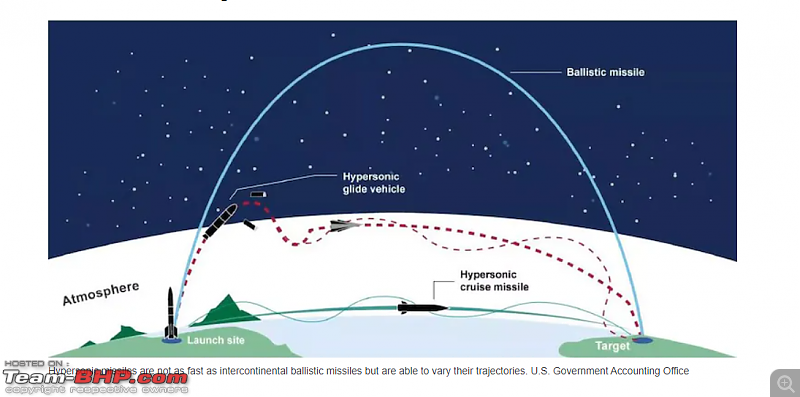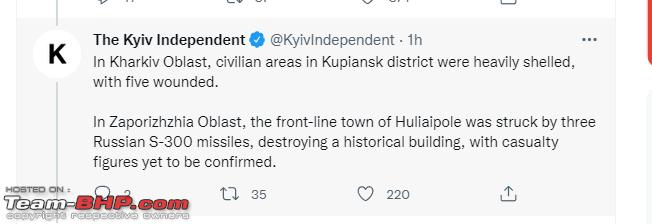Hypersonic Missiles
Articles by journalists on hypersonic missiles are all over the internet especially after China claimed to have developed one, followed by India’s launch of a prototype and the Russian forces in Ukraine using a Kinzhal hypersonic missile to hit a target. Many on Team BHP are very knowledgeable so this post may be of less value to them. The rest of the enthusiasts I thought might like to know a little more in layman’s terms of this weapon. Hence this post.
What is hypersonic?
Describing a vehicle as hypersonic means that it flies much faster than 5 times the speed of sound, which is 1,225 kilometers per hour at sea level and 1,067 kph at 35,000 feet where passenger jets fly. So at altitude that’s a speed in excess of 5400 kmph or 1500 metres per second. A bullet from a powerful rifle typically does ~900 metres per second give or take a little.
Hypersonic systems have been in use for decades. All of the intercontinental ballistic missiles {ICBM} in the world’s nuclear arsenals are hypersonic, reaching about 24,000 kmph at their maximum velocity on re-entry.
ICBMs are launched on large rockets and then fly on a predictable trajectory that takes them out of the atmosphere into space and then back into the atmosphere again. The new generation of hypersonic missiles fly very fast, but not as fast as ICBMs. They are launched on smaller rockets that keep them within the upper reaches of the atmosphere and do not necessarily fly a predictable ballistic trajectory.
What is a hypersonic flight path
The diagramme below describes it best. A hypersonic flight path is manoueverable like that of a cruise missile. The hypersonic missile flies between say 200,000 feet {60,000 metres} to sea level typically starting its flight at a higher altitude and coming down to a lower altitude in the homing phase. It can change course in flight making its flight path unpredictable other than being blindingly fast and these two factors make shooting it down impossible with current and forseeable technology.
 Types of hypersonic missiles
Types of hypersonic missiles
There are three different types of hypersonic missiles:
(a) aero-ballistic,
(b) glide vehicles and
(c) cruise missiles.
A hypersonic aero-ballistic system is dropped from an aircraft, accelerated to hypersonic speed using a rocket and then follows a ballistic, meaning unpowered, trajectory. The system Russian forces used to attack Ukraine, the Kinzhal, is an aero-ballistic missile. The aero-ballistic is the earliest variant as a launch from a mother aircraft gives the missile some speed and altitude at launch itself.
A hypersonic glide vehicle is boosted on a rocket to high altitude and then glides to its target, manoeuvering along the way. Examples of hypersonic glide vehicles include China’s Dongfeng-17, Russia’s Avangard and the U.S. Navy’s Conventional Prompt Strike system. U.S. officials have expressed concern that China’s hypersonic glide vehicle technology is further advanced than the U.S. system. But I find that very hard to believe.
A hypersonic cruise missile is boosted by a rocket to hypersonic speed and then uses an air-breathing engine called a scramjet to sustain that speed. Because they ingest air into their engines, hypersonic cruise missiles require smaller launch rockets than hypersonic glide vehicles, which means they can cost less and be launched from more places. Hypersonic cruise missiles are under development by China and the U.S. The U.S. reportedly conducted a test flight of a scramjet hypersonic missile in March 2020.
Why are hypersonics difficult to defend against
The primary reason nations are developing these next-generation hypersonic weapons is how difficult they are to defend against due to their speed, manoeuverability and flight path. Radars struggle to track them due to their speed. Even if you were lucky enough to get a SAM missile fired off that SAMs guidance and homing system won’t be able to cope with locking on to a target closing in on the SAM missile at say Mach 9.0 {Mach 7.0 of the hypersonic missile and Mach 2.0+ of the SAM itself }. The ability to change flight paths makes them immune to the anti-ballistic missile defences that some countries have put up.
However as with any other weapon hypersonics are not the proverbial silver bullet. They can cause damage or destruction to a large warship or building or runway but there are many other weapons that can do that with a high degree of accuracy and at a fraction of the cost.
Where does India stand
We are developing two hypersonics. One is Brahmos-IIK a 1000 kms weapon which is being developed jointly with Russia and is in the cruise missile category. The other is Shaurya a 750 kms weapon which seems to be more like the glide vehicle category. But these are only guesses and I could be totally off the mark. What will be there role in our strategic assets will unfold with time.
The Chinese DF-17 is a intermediate range ballistic missile with a hypersonic missile as its warhead. They went down tat route as they believed it was the fastest practical manner to have something, albeit crude, operational at the earliest.
The only live use of a hypersonic occurred recently in the Ukraine war where a Russian Kinzhal missile, seen below being carried by a MiG-31, was used against a target in Odessa.

 (7)
Thanks
(7)
Thanks

 (4)
Thanks
(4)
Thanks

 (3)
Thanks
(3)
Thanks

 (2)
Thanks
(2)
Thanks

 (2)
Thanks
(2)
Thanks
 (3)
Thanks
(3)
Thanks
 (2)
Thanks
(2)
Thanks
 (2)
Thanks
(2)
Thanks
 (7)
Thanks
(7)
Thanks

 (5)
Thanks
(5)
Thanks

 (36)
Thanks
(36)
Thanks
 (13)
Thanks
(13)
Thanks
 (4)
Thanks
(4)
Thanks
 (4)
Thanks
(4)
Thanks

 (2)
Thanks
(2)
Thanks





 and add to that the lukewarm reaction from Pakistan.
and add to that the lukewarm reaction from Pakistan. 
 ) of AA missiles. Just recently, the production of the ASRAAM missile started in India but I believe the only fighter that can fire this missile in our inventory is the SEPECAT Jaguar (and maybe the Tejas too, not entirely sure). Also, if the Indian Navy chooses the F/A-18 Super Hornet which seems more than likely, we would probably end up having the sidewinder and AMRAAM as well. Inventory management is really gonna be a challenge!
) of AA missiles. Just recently, the production of the ASRAAM missile started in India but I believe the only fighter that can fire this missile in our inventory is the SEPECAT Jaguar (and maybe the Tejas too, not entirely sure). Also, if the Indian Navy chooses the F/A-18 Super Hornet which seems more than likely, we would probably end up having the sidewinder and AMRAAM as well. Inventory management is really gonna be a challenge!

